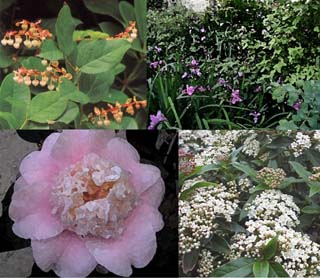
Surveys
DJC.COM
April 22, 2004
Low-allergen landscapes nothing to sneeze at
Nakano Associates

Bateman
|
Concentrated in urban areas, asthma affects one in six low-income families, twice the rate for the general population, and is the number one chronic diseased suffered by American children. These statistics clearly identify a need to further define and address air quality in our urban areas.
Clean air at High Point
The Healthy Homes Initiative program has provided just such an opportunity for West Seattle's 120-acre High Point Hope VI Redevelopment, a Seattle Housing Authority mixed-income community.
The initiative is a collaboration of public and private organizations that brings together community-based education, new construction, and scientific evaluation to improve the health and lives of the community's residents. It is funded through grants from the U.S. Department of Housing and Urban Development and the National Institute of Environmental Health Sciences.
The initiative presented the design team an opportunity to focus on the environmental sustainability issues that impact asthma and other respiratory health problems within the community by evaluating the overall design, construction methods and materials used in large scale landscape development in order to mitigate problems caused by airborne allergens.
Understanding the connection between asthma and allergies was fundamental to accomplishing this task. Research showed that the more chemicals and airborne substances a person is exposed to, the more allergies, or sensitivities, they develop. Although asthma can develop at any age, in those under the age of 30 it is more likely to be triggered by allergies, especially pollen-based.
Pollen pollution

Sketch by Brad Kurokawa
Landscaping at West Seattle’s High Point redevelopment includes low-allergen plants.
|
Designers have long been aware of the mental and physical health benefits of vegetation in urban environments but have seldom looked at the issue of pollen pollution.
A significant correlation with the escalation of asthma cases has been the dramatic increase over the past 20 years in the use of dioecious male cultivars and monoecious cultivars in urban landscapes in an effort to minimize the female characteristics of trees, often deemed “messy,” and a subsequent upsurge in urban pollen counts. Turning this pollen tide around will require looking at landscape design from the standpoint of macro and microenvironments, as well addressing post construction allergen mitigation.
Providing easy access to low- or no-allergen areas for exercise and fresh air affords significant preventative measures to be taken, including reducing allergens within the microenvironments where children spend much of their time, i.e. their own backyards and the community spaces within their neighborhoods.
However, greater allergen reduction can be achieved by looking at the landscape as a whole rather than a collection of individual landscapes. Using strategies to identify and reduce overall allergens and irritants, including pollens and chemicals used in the construction of outdoor structures and hardscapes, further reduce the incidence of allergens and their resulting impacts to the overall health of the community.
An allergen rating system can be used to develop a plant selection strategy, incorporating plant diversity and hardiness, to reduce the amount of airborne pollen. Plant diversity accesses the overall balance of male and female plants to achieve a more appropriate balance of ground to airborne “litter," and uses a range of species based on their allergen ratings.
Plant hardiness considers plants from a maintenance aspect, avoiding plants requiring a lot of chemical support such as pesticides and fertilizers. Native plants with good allergy ratings are preferred, as they are less prone to pests and disease, are drought tolerant, and need little maintenance once established.
Low-allergen, high-interest plants

Image by Audrey Bateman
Low-allergen plants can be good looking, too.
|
Lawns pose an interesting dilemma in a low allergen landscape. If a lawn is sufficiently maintained it can serve as a good pollen collector or sink. However, if maintenance is neglected, it can become a major source of asthma aggravation.
In order to avoid this outcome, large lawn areas should be limited to central community areas in order to control maintenance. A mowing schedule designating afternoon cuts to reduce pollen release and the posting of warning flags during periodic chemical treatments will also lessen exposure to allergens.
Other specifications include adequate initial soil amendment, integral to the ongoing health of plant material, as the addition of mold-harboring organic mulches is not recommended. Once the initial amendment has been made, low-allergen mulch such as a rounded, washed gravel or dense groundcover should be specified, along with fertilizer alternatives such as compost teas, which immediately absorb into the soil and actually suppress airborne pathogenic fungi. Maintenance specifications should also include the use of nontoxic, organic-based products and integrated pest management plans.
Hardscape design should avoid toxic substances frequently used in construction materials. These materials include solvent-based concrete sealers, concrete admixtures containing sulfonated melamine, formaldehyde condensates, sulfonated naphthalene and other potentially harmful ingredients. Also bad are aniline-based coloring agents containing chromium and other heavy metals, wood treated with pentachlorophenol and wood adhesives containing harmful solvents. Non-allergen alternatives are available for all these products and should be specified.
Albert Einstein once said, “The significant problems we face cannot be solved at the same level of thinking we were at when we created them.” Juvenile asthma is a severe problem facing our urban communities. While no single action, or design, is going to reverse this problem, the more we address the issue, the closer we will get to providing healthy, sustainable urban environments.
By involving the community and incorporating environmental education and community service programs in further promoting low-allergen gardening practices; significant long-term benefits can be achieved on the overall health and sustainability of a community.
Audrey Bateman is an associate with Nakano Associates LLC, Landscape Architects.
Other Stories:
- Gardeners go trowel to trowel in contest
- Art meets Frisbees in north Seattle park
- What is your landscape telling you?
- Seattle's big chance to reconnect the waterfront
- Keeping runoff out of sight, but still in mind
- Ecological restoration goes beyond trees and shrubs
- Amgen unwraps the landscape at Helix
- Landscape designers promote active lifestyles
- The do's and don'ts of planting new trees
- Shared streets can provide open space, too
- Landscape connects rivers and cultures
Copyright ©2009 Seattle Daily Journal and DJC.COM.
Comments? Questions? Contact us.